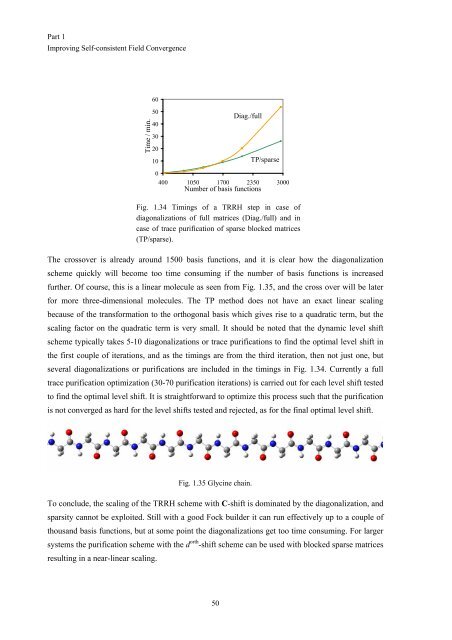Get my PhD Thesis
Get my PhD Thesis
Get my PhD Thesis
Create successful ePaper yourself
Turn your PDF publications into a flip-book with our unique Google optimized e-Paper software.
Part 1<br />
Improving Self-consistent Field Convergence<br />
60<br />
Time / min.<br />
50<br />
40<br />
30<br />
20<br />
10<br />
Diag./full<br />
TP/sparse<br />
0<br />
400 1050 1700 2350 3000<br />
Number of basis functions<br />
Fig. 1.34 Timings of a TRRH step in case of<br />
diagonalizations of full matrices (Diag./full) and in<br />
case of trace purification of sparse blocked matrices<br />
(TP/sparse).<br />
The crossover is already around 1500 basis functions, and it is clear how the diagonalization<br />
scheme quickly will become too time consuming if the number of basis functions is increased<br />
further. Of course, this is a linear molecule as seen from Fig. 1.35, and the cross over will be later<br />
for more three-dimensional molecules. The TP method does not have an exact linear scaling<br />
because of the transformation to the orthogonal basis which gives rise to a quadratic term, but the<br />
scaling factor on the quadratic term is very small. It should be noted that the dynamic level shift<br />
scheme typically takes 5-10 diagonalizations or trace purifications to find the optimal level shift in<br />
the first couple of iterations, and as the timings are from the third iteration, then not just one, but<br />
several diagonalizations or purifications are included in the timings in Fig. 1.34. Currently a full<br />
trace purification optimization (30-70 purification iterations) is carried out for each level shift tested<br />
to find the optimal level shift. It is straightforward to optimize this process such that the purification<br />
is not converged as hard for the level shifts tested and rejected, as for the final optimal level shift.<br />
Fig. 1.35 Glycine chain.<br />
To conclude, the scaling of the TRRH scheme with C-shift is dominated by the diagonalization, and<br />
sparsity cannot be exploited. Still with a good Fock builder it can run effectively up to a couple of<br />
thousand basis functions, but at some point the diagonalizations get too time consuming. For larger<br />
systems the purification scheme with the d orth -shift scheme can be used with blocked sparse matrices<br />
resulting in a near-linear scaling.<br />
50

















